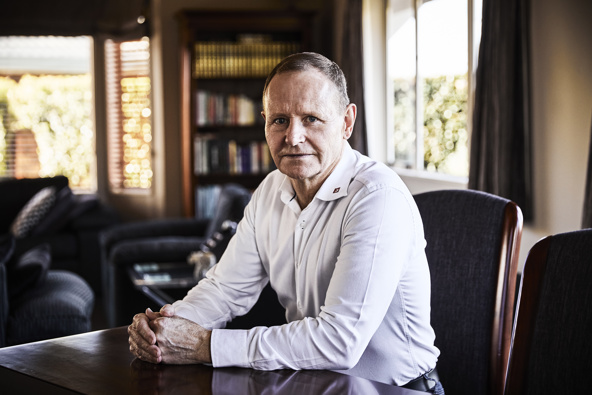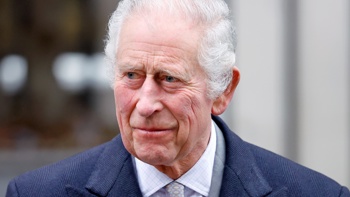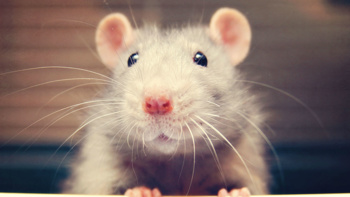Former police negotiator Lance Burdett started writing his new book while he was studying for a diploma in positive psychology. Then something tragic happened – his 17-year-old niece took her own life.
His world was irreparably changed. This loss proved to him that adversity can hit anyone at any time, often unexpectedly.
The loss, combined with Burdett's own experience of depression, spurred him to share the lessons he's learned about how the brain works.
Burdett spent 22 years in the police, running many high-risk negotiations including the Napier Siege and specialising in suicide intervention and prevention.
He now provides presentations and workshops on how to overcome the pressure and stress that a modern world brings to our slow-developing brain.
In the below extract from his new book, Dark Side of the Brain, Burdett talks about overcoming his demons and how we can protect our young people.
In 1999, I hadn't been looking after myself and I started heading down into that dark place where many of us find ourselves when we face adversity in our lives. Unlike previous times, this time I went deeper than ever before and found it was much easier to keep heading down than to climb back out. It was too much effort and I was becoming tired — too tired to fight.
I found it much easier to replace natural sleep with medicated rest, talking to others with talking to myself, looking others in the eye with staring at the ground, asking for help with going it alone, and identifying that I was unwell and needing help with working through it myself.
Where did that get me? To the bottom of a pit, stuck in the mire. It was not a pleasant place to be.
What was happening with me? Why was it easier to slide down into the mire than it was to keep fighting and climb out? The answers have now become apparent. The longer I stayed in the mire, the deeper and faster I sank. The downward spiral increased. Trying to stop the negative thoughts was incredibly difficult, impossible it seemed at the time. My mind started to tell me to do the opposite of what I should have done. It told me to hide, to avoid contact with people, to not go out of my home, to not exercise, to stay inside a darkened room, to go to bed and try to sleep in the hope that tomorrow might be different.
I continued on this downward spiral of increasingly relentless negative thoughts. The negative thoughts were forming neural pathways in my brain, rivers of negative thoughts, so much so that everything seemed to be insurmountable and I couldn't seem to change my thoughts. It became easier to keep travelling down the river rather than swim against the flow.
The downward spiral continued taking me down. I allowed my negative thoughts to take hold and didn't stop them early enough, so they continued to the point where I ended up feeling hopeless and helpless. There was no way out and I couldn't control it, I had failed, I was a failure ... yet again. And, I was hurting those around me by not being there for them.
/cloudfront-ap-southeast-2.images.arcpublishing.com/nzme/5DWHQAMS3RCG3CPK2WXJJENIVY.jpg)
I could function adequately but wasn't fully coherent in whatever I was doing. I was behaving just like a robot. Every single bad thing that had ever happened in my life was as fresh as though it had happened yesterday. I kept telling myself that this sort of thing only happened to other people and that I just needed to work through it ... keep going, it will get better, you've got this ... The simple automatic process of breathing became the most difficult thing in the world to do and was all-consuming. I become stuck in the mud and didn't know what to do to get out. I felt like I'd tried most things already. I started to believe life was going to be like this forever, so I tried to function as though it was inevitable. "Why can't I just be normal again?" I asked myself. Of course, none of this was real, it was all going on inside my head.
I was still working. I'd even received a high honour — a bronze merit award — for working on a homicide investigation while also preparing an earlier homicide case for the Crown Solicitor. But the reality was I was trying to keep my mind occupied with work rather than the ever-increasing dark thoughts, trying to distract me from what was really going on. I was fully functioning on the outside yet on the inside I was falling apart. Working on two major files gave me the opportunity to run away from my thoughts, but no matter how much I tried, they kept catching up on me.
You could never have told me that at the time of my crisis that these things are just inside of my head because rational thought had long disappeared. If you had told me when I was in the dark hole that I could recover, I would have dismissed you immediately. "I can't recover, you don't understand, this is now who I am, forever," I would have thought to myself.
Sitting on the veranda at home feeling tired and lost, I wondered if it was worth going on, if I should keep fighting. I'd been fighting for so long. I was hurting those I love by carrying on ... Maybe it would be best if I wasn't here so that they could get on better without me ... Then I heard my children playing in the backyard. That was enough for me — enough to inspire me to keep going so that I could be there for them and watch them grow. At the time, wanting to be there for them made me feel a little selfish. "It's always about you, Lance," that voice in my head said.
Yet that very moment changed my life forever. I sat there and went through a mind technique I'd been shown by my psychologist, but this time something was different. Something inside of me had become engaged — my heart. Thoughts of my family — the very thing that had kept me going throughout my troubled times, had been my hook — came to the fore. I thought about my wife, our children and our pets — the things I dearly loved.
Everything suddenly became clearer and I had a newfound determination, a new energy to continue. I had belief, belief in myself.
Strength comes when we need it the most — in times of danger. And, the strength that we find from inside of our heart is extremely powerful. We are all stronger than we think we are. When strength is all we have left, we just have to believe, to believe it in our hearts. We fight rather than flee.
It should have been obvious to me. As a crisis negotiator, I'd been taught to look for the hook when talking with people who are intending to commit suicide, the thing that has kept them going during the troubled times. My family kept me going all of this time and I held on to that belief throughout, yet I thought I was hurting them by being unwell. I thought I was hurting them by not being present should they ever need me. I thought I was hurting them because I was emotionless, disengaged.
I now have that moment in time immortalised in a tattoo that I wear proudly — a fist rising out of a swirling whirlpool, clenching onto a human heart. It signifies my reaching inside of myself and grabbing hold of my heart to gain the strength needed to climb out of the dark hole.
Protecting our young
For our young, irrational thoughts of "my life is s***" can be because the rational brain doesn't fully develop until the age of 25, so they are unable to rationalise their thoughts around what has happened when a series of impactful events hit them. They no longer have energy to fight their thoughts, so their automaton mind takes over much faster than in an adult. They are usually unable to see the consequences of their actions and often make spur-of-the-moment decisions in life, more so when they are considering death, so suicide can be a hasty decision. If they could only see the consequences of their contemplated action.
Our young are more easily influenced. Could the very thing that pushes them to take their own life be a copycat act or a suicide pact?
Copycat suicide, also known as contagion suicide, often appears in clusters and the reasons for it are complex. According to the Centre for Suicide Prevention in Canada, there are two types of clusters. The first is a mass cluster, which involves suicides that cluster in time irrespective of geography. These are often associated with the influence of media, particularly with suicides of celebrities. The second is a point cluster, in which the suicides happen close together in both time and place.
Point clusters are the biggest concern for our susceptible young.
/cloudfront-ap-southeast-2.images.arcpublishing.com/nzme/WZJSRCGXUJEXDCHWNNXKNNDXKY.jpg)
They are difficult to analyse because they have so many contributing factors. As reported in the BMC Public Health journal in November 2018, studies among indigenous populations in Canada found that point clusters occurred more often in communities where people had little or no sense of belonging. There are similar studies in other countries associated with indigenous populations. I hypothesise that the same happens in schools if the young person feels alienated or ostracised.
Our young are particularly influenced by the media. A report into the impact of news coverage about suicide published through the Harvard Kennedy School in 2016 showed an increase in suicide rates after both nonfictional and fictional stories were published about suicide. After the Netflix series 13 Reasons Why aired in March 2017, internet searches for the word "suicide" rose by 20 per cent globally. A report published in the Journal of the American Academy of Child and Adolescent Psychiatry found that "the number of suicides among Americans aged 10-17 in April 2017 was greater than any other month over the five-year period examined. Overall, there were 195 more suicides than expected in the nine months after the show premiered, based on historical and seasonal trends."
The report goes on to state: "While there's no direct causation cited in the report, the unprecedented rise has left cause for concern." A later study published in JAMA Psychiatry showed similar findings.
Many young people responding to a survey conducted in the United States indicated that having had a friend or loved one commit suicide made it easier for them to consider it as an option for themselves.
Analysis of data gathered from high school students from the National Longitudinal Study of Adolescent to Adult Health across the United States found that teens who had friends or family members who had committed suicide were about three times more likely to attempt suicide than those who did not know someone who had attempted suicide.
There are a number of evidence-based intervention strategies capable of mitigating suicide contagion. Bereavement support and the provision of intervention strategies for our young are the best responses to reduce the risk of cluster affect. Informing all families who have students at the same school of the death, including that it was a suicide (with permission from the surviving parents), is vital so that parents can keep a watch on their own child. Organising group-based counselling sessions and meeting with the deceased's close friends is important.
De-glamorising funerals is also important given that young adults are highly emotional when attending the funeral of a close friend.
Most who have survived suicide, commonly referred to as an attempt, will tell you that they are glad to have survived — and they are. A lot of survivors of suicide will go on to help others, to give back, to make amends, to tell their story, to be thankful for a new chance at life. And that is what we all should do, pass on our knowledge to help others. It is our duty because we were given the gift of insight and were fortunate to survive.
/cloudfront-ap-southeast-2.images.arcpublishing.com/nzme/JJY7ESW4PFHSJJU76ISR4T7V6A.jpg)
Dark Side of the Brain: Adapting to Adversity
By Lance Burdett
RRP $39.99
Out now
Published by Bateman Books
Where to get help
If it is an emergency and you feel like you or someone else is at risk, call 111.
• Lifeline: 0800 543 354 (available 24/7)
• Suicide Crisis Helpline: 0508 828 865 (0508 TAUTOKO) (available 24/7)
• Youth services: (06) 3555 906
• Youthline: 0800 376 633
• Kidsline: 0800 543 754 (available 24/7)
• Whatsup: 0800 942 8787 (1pm to 11pm)
• Depression helpline: 0800 111 757 (available 24/7)
• Rainbow Youth: (09) 376 4155
• Helpline: 1737
Take your Radio, Podcasts and Music with you










